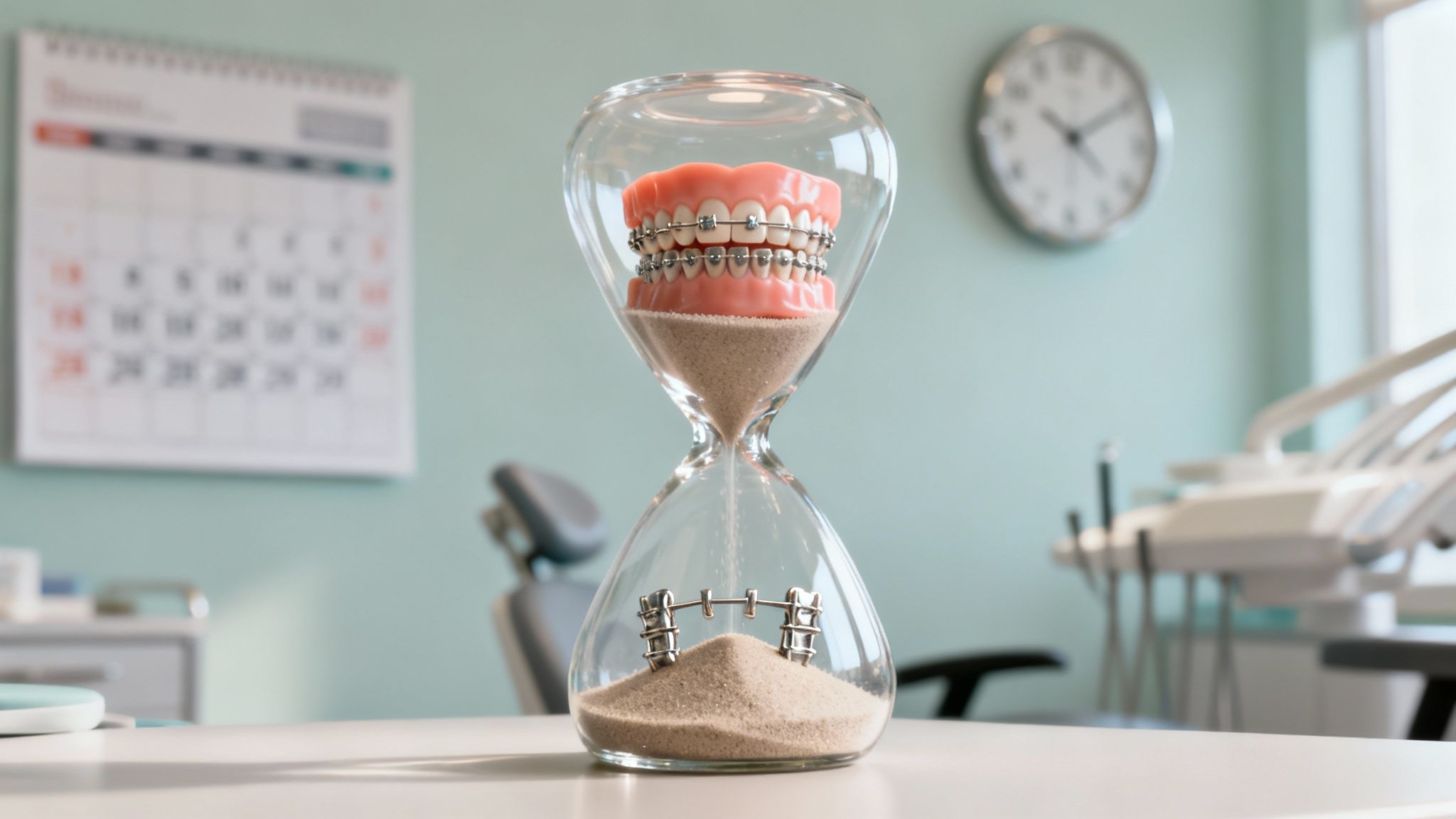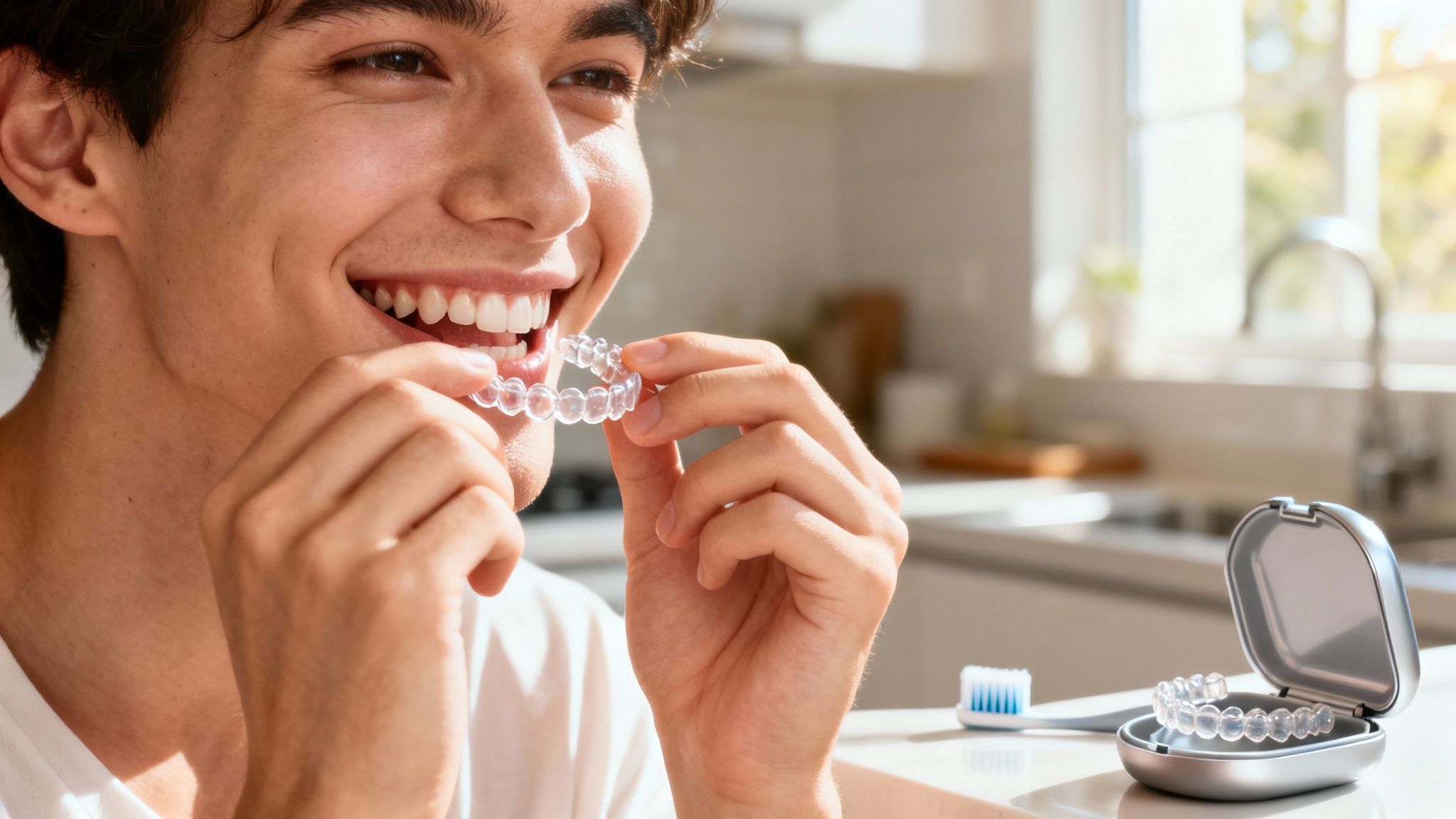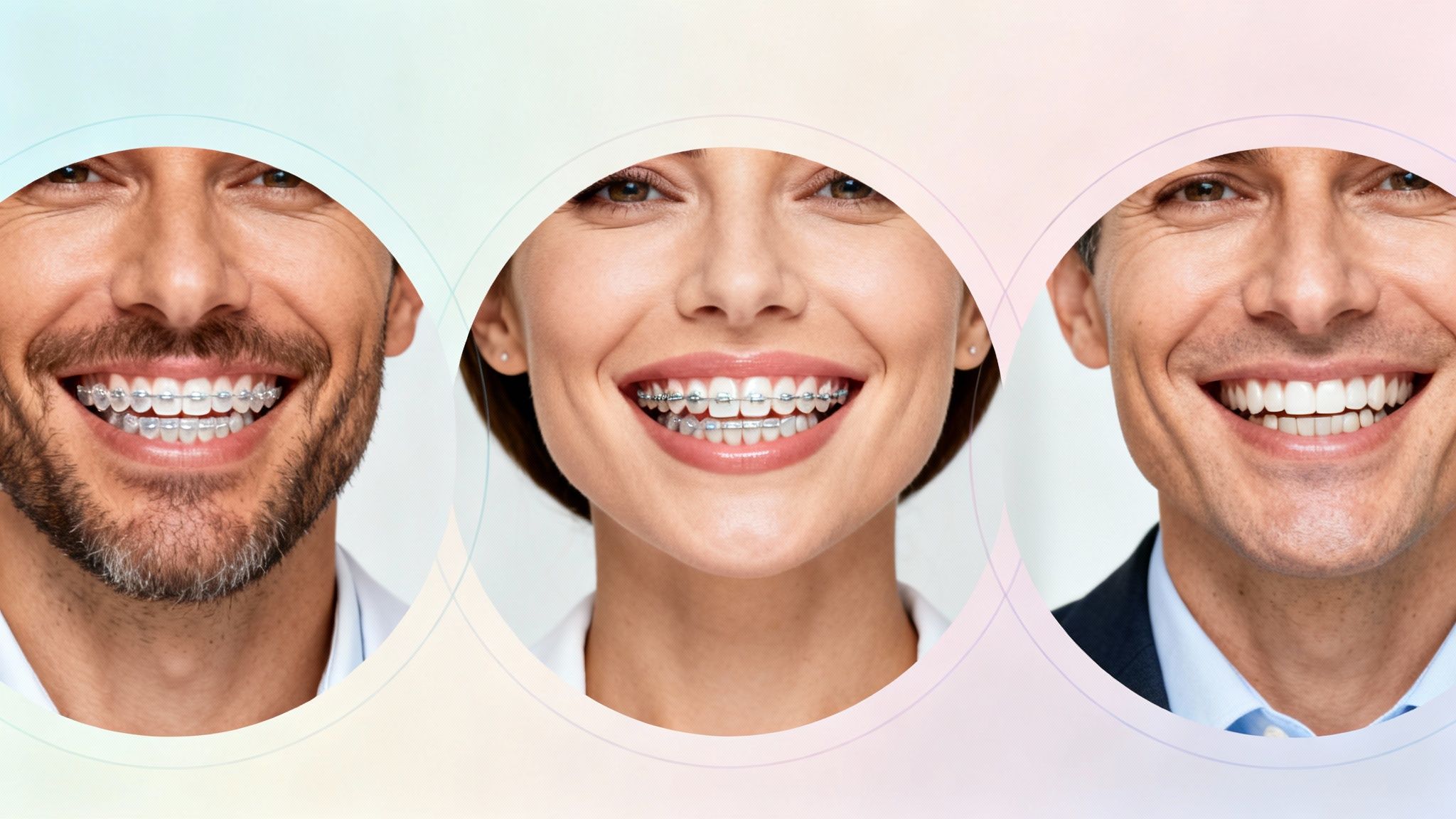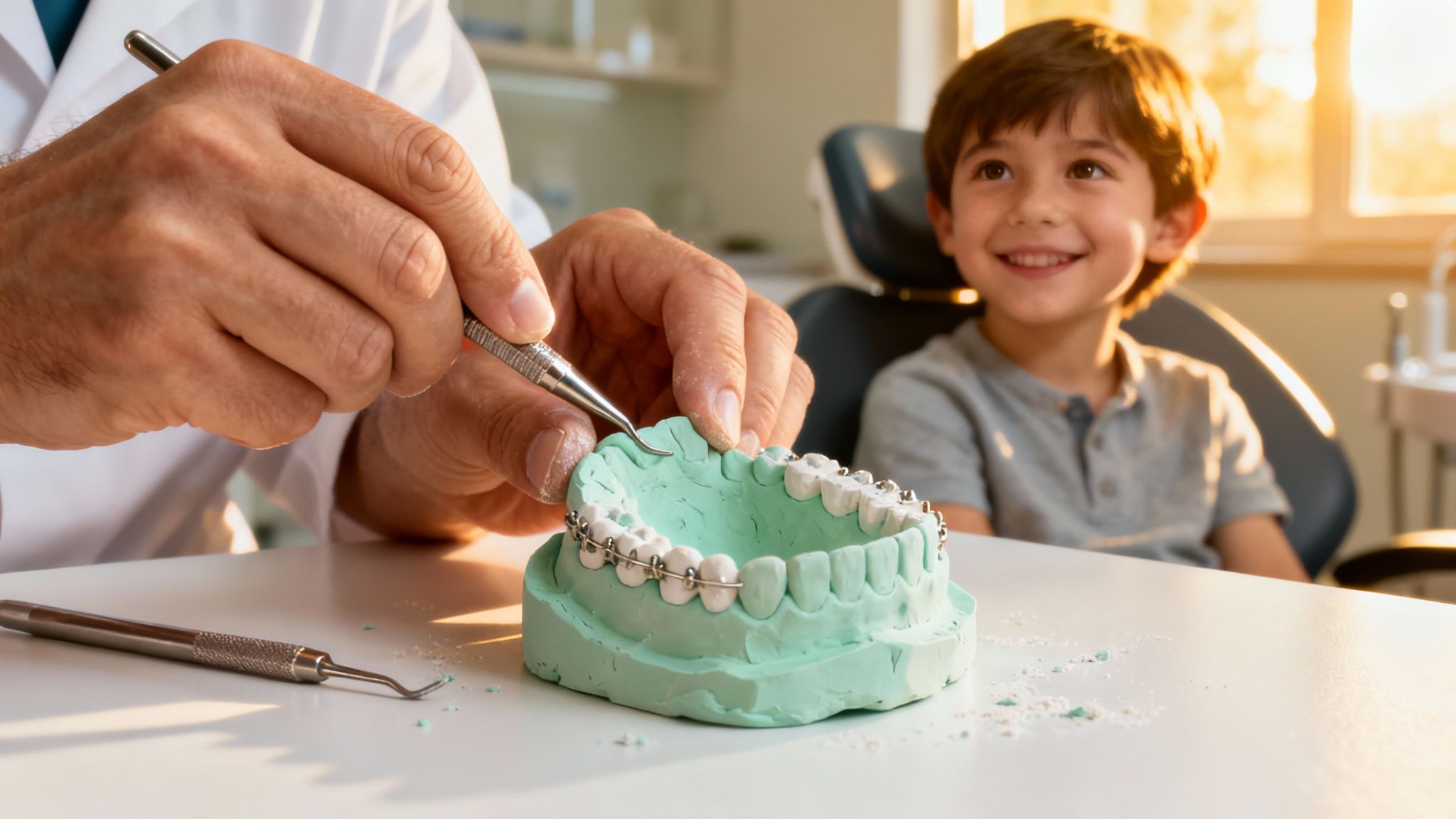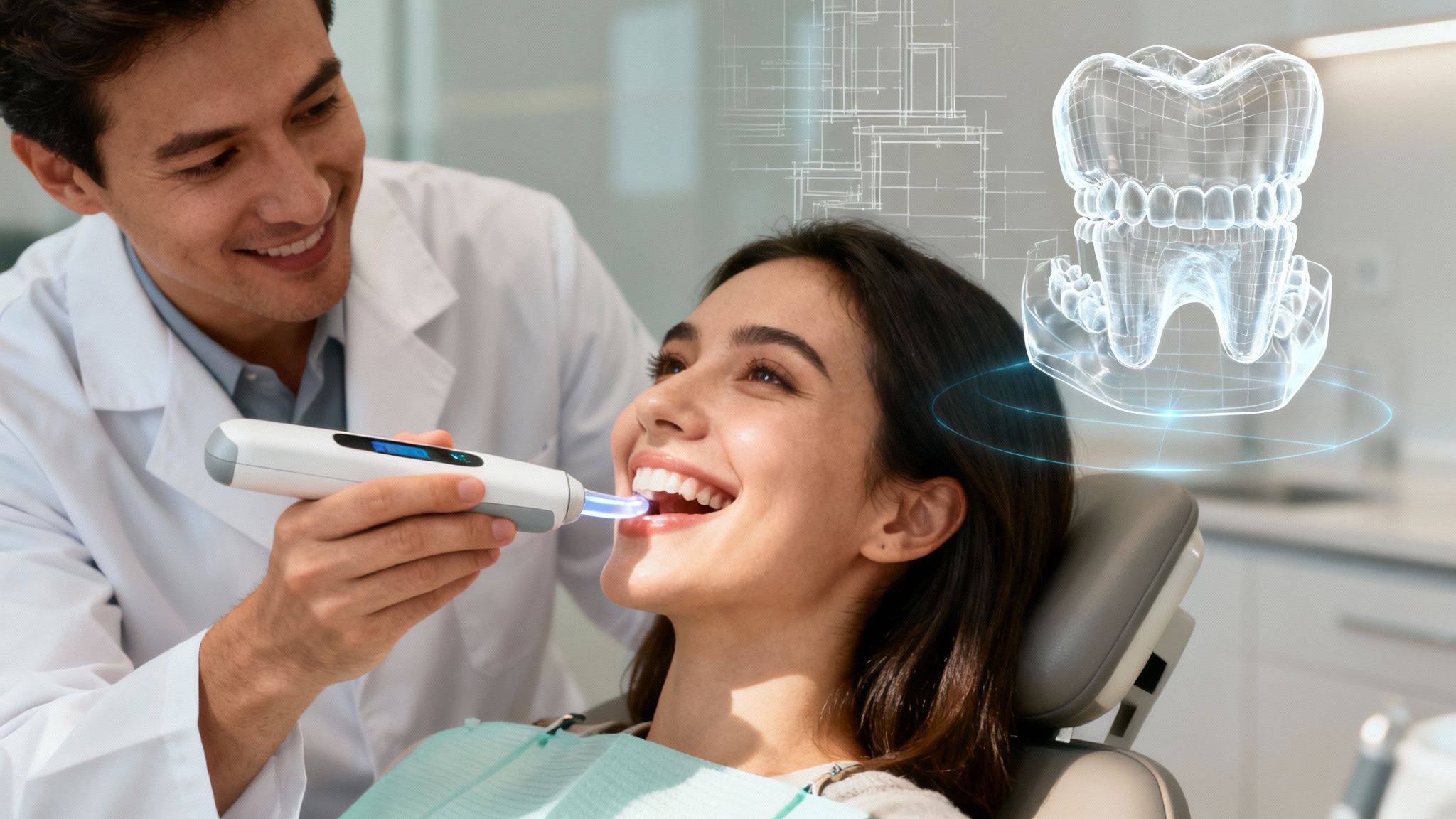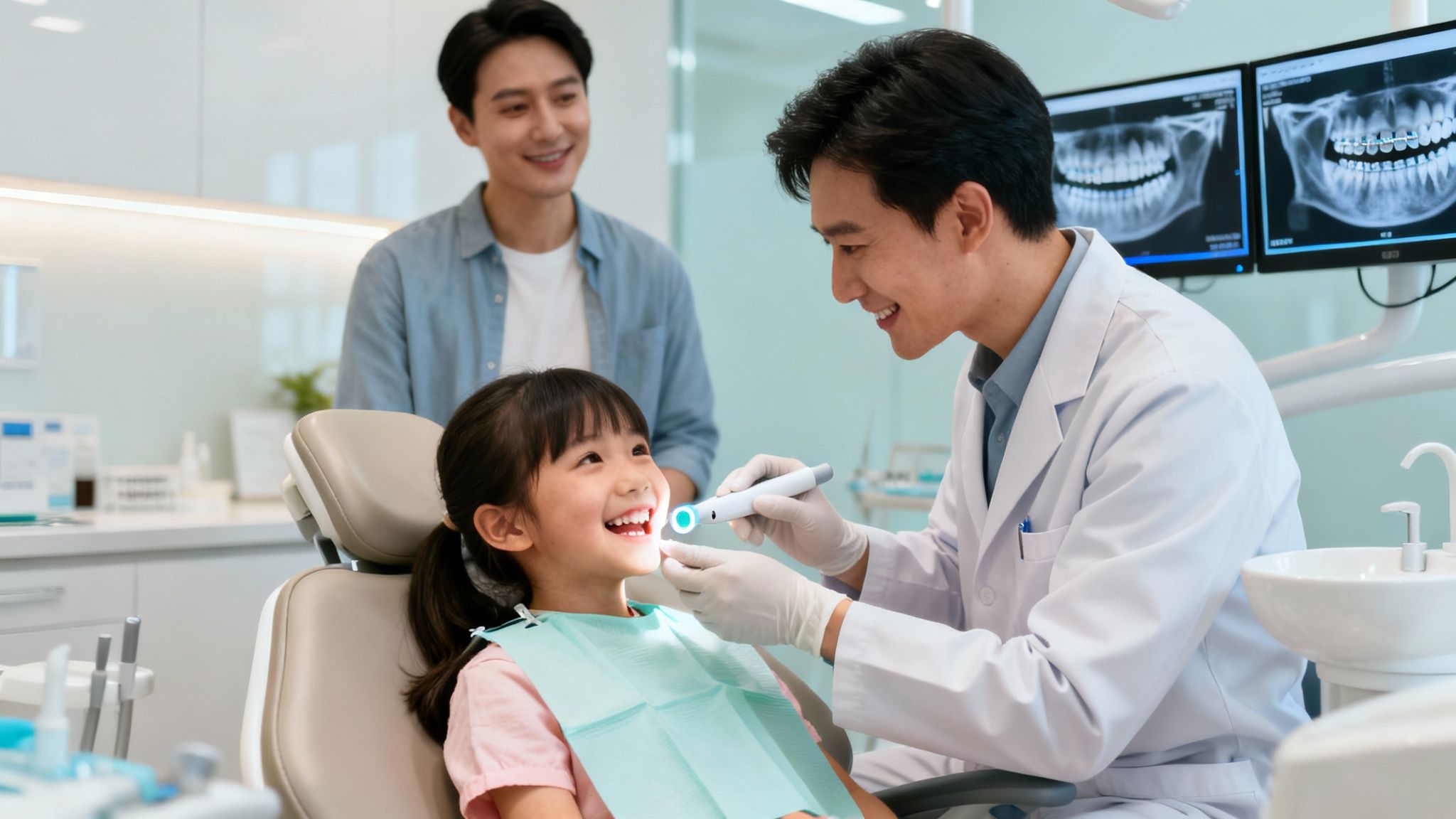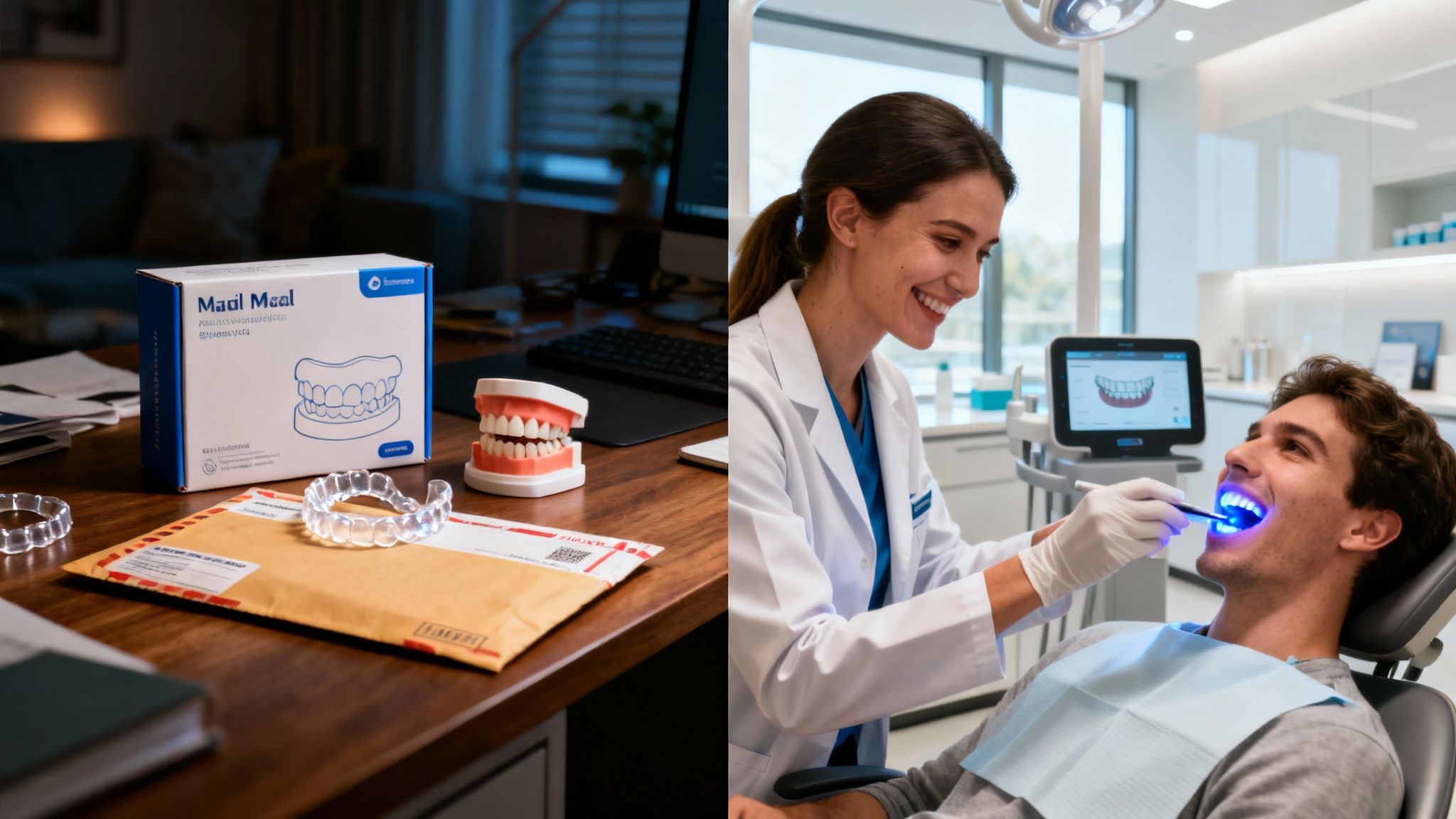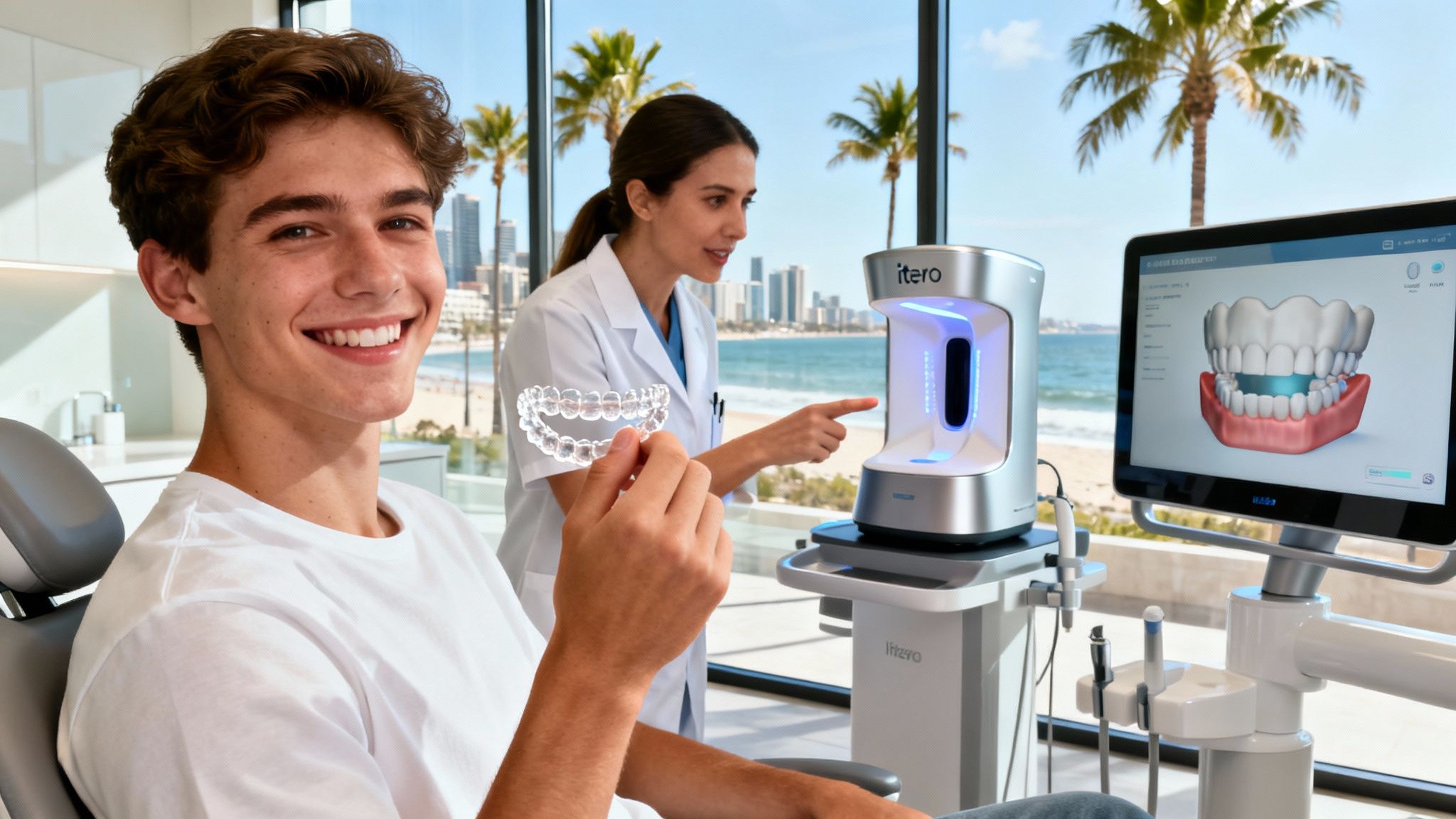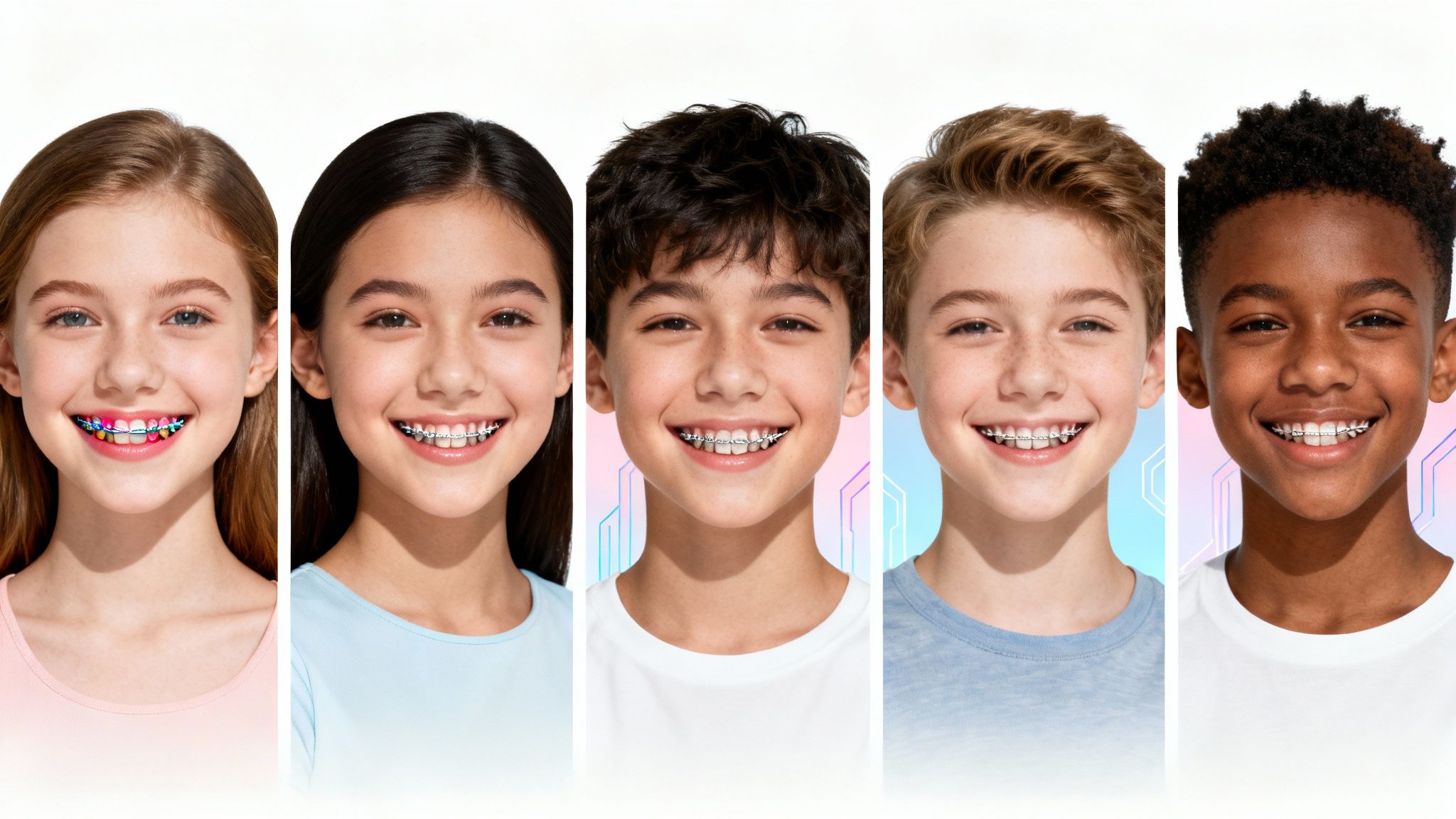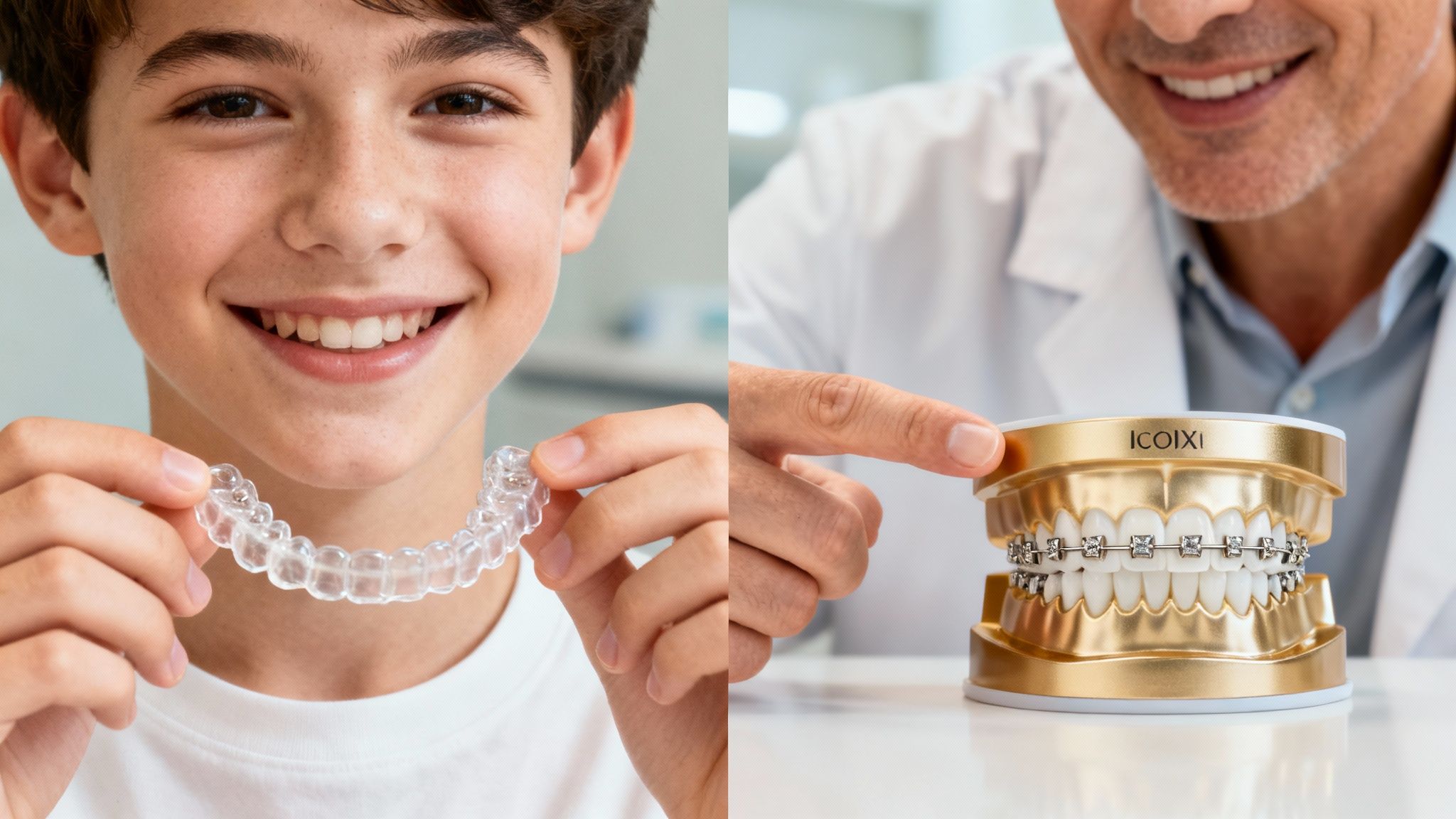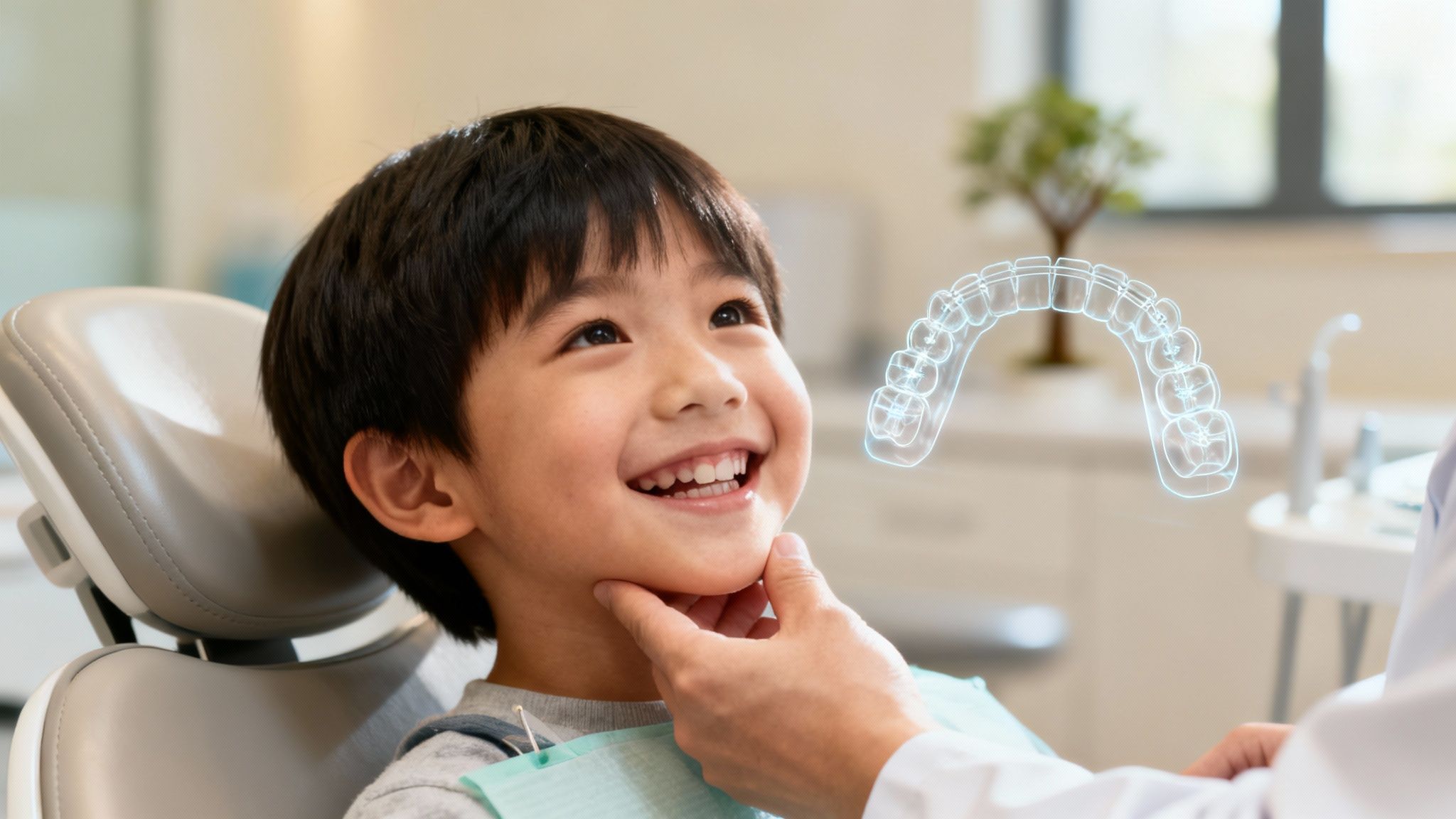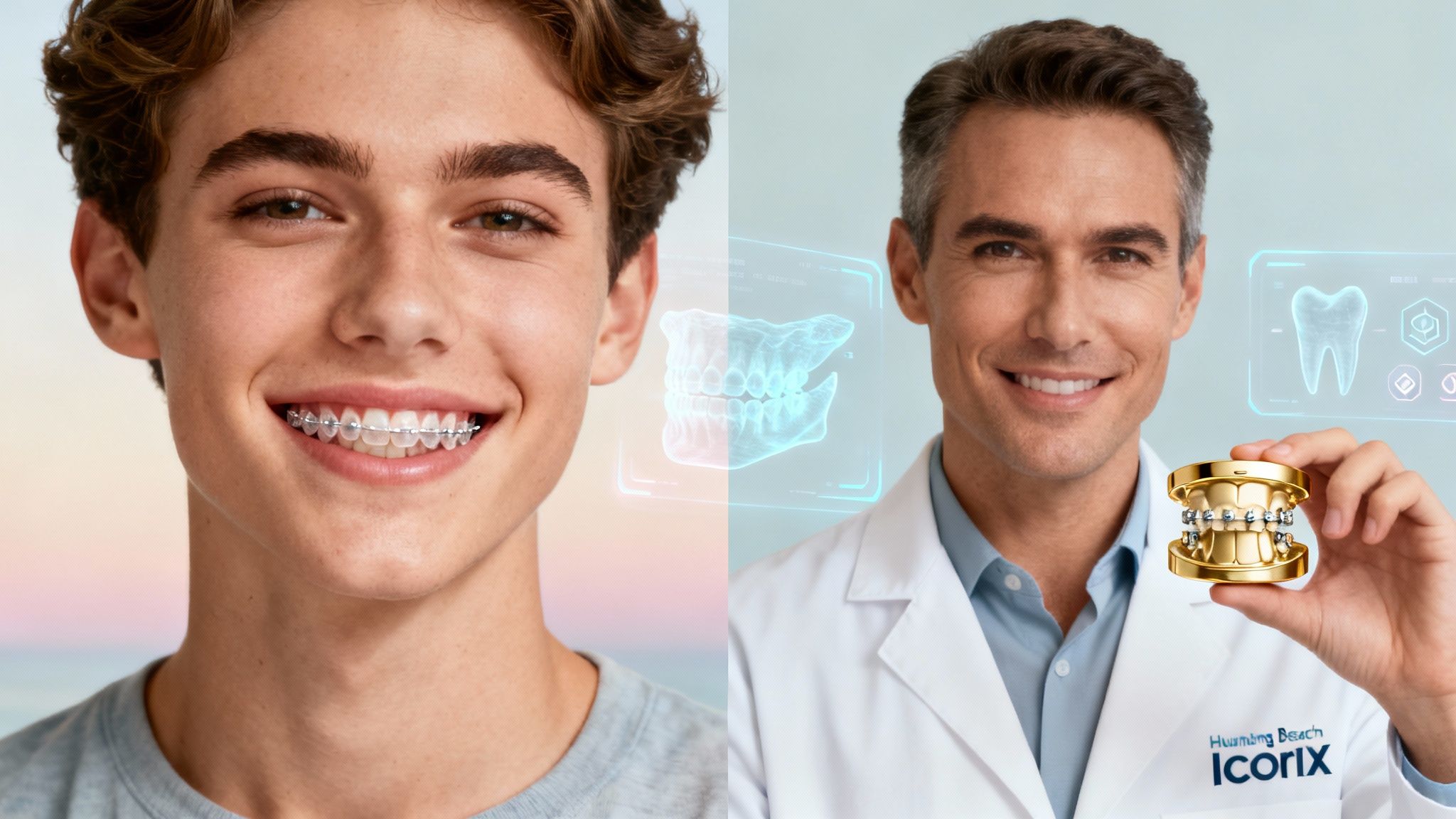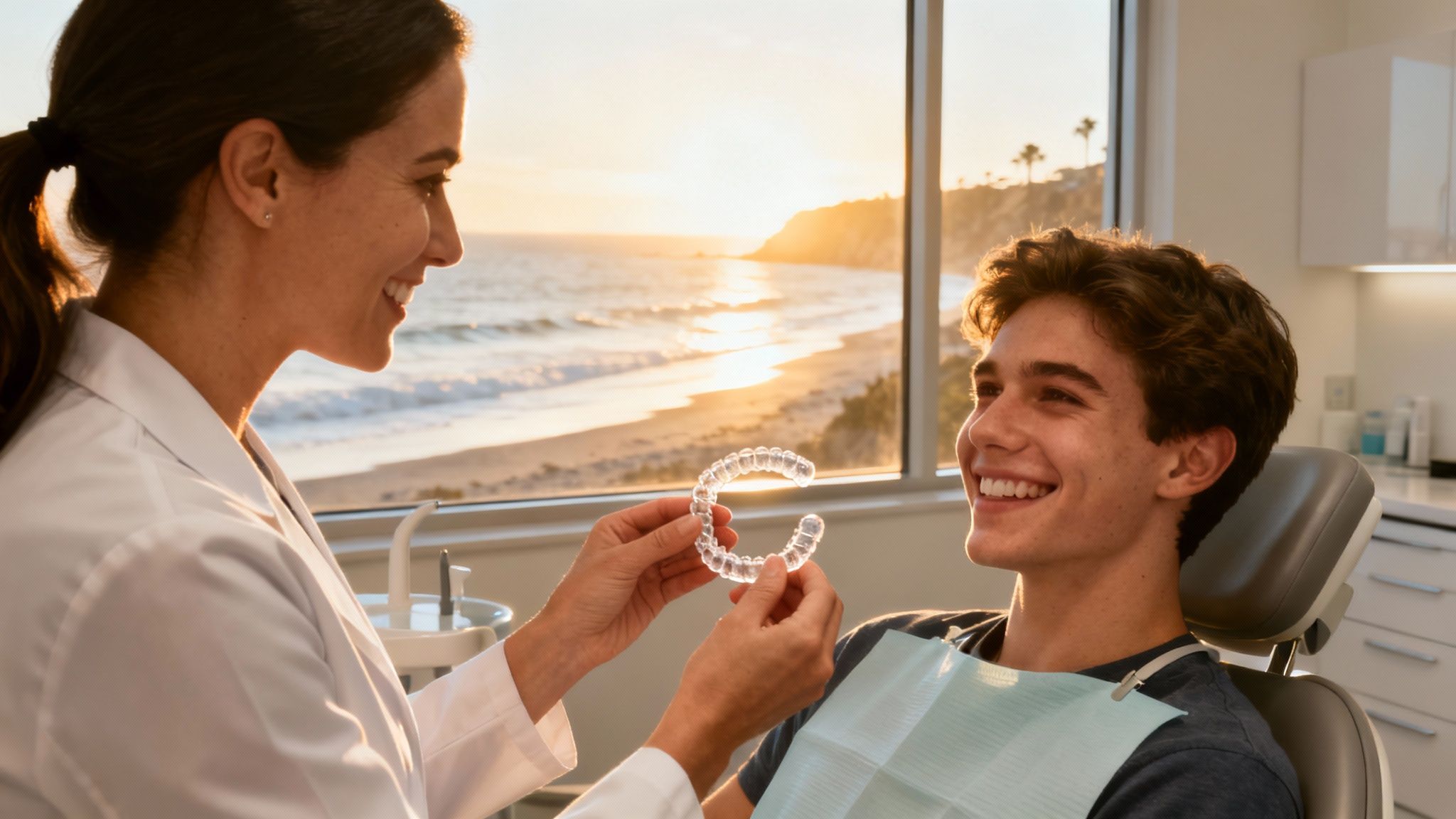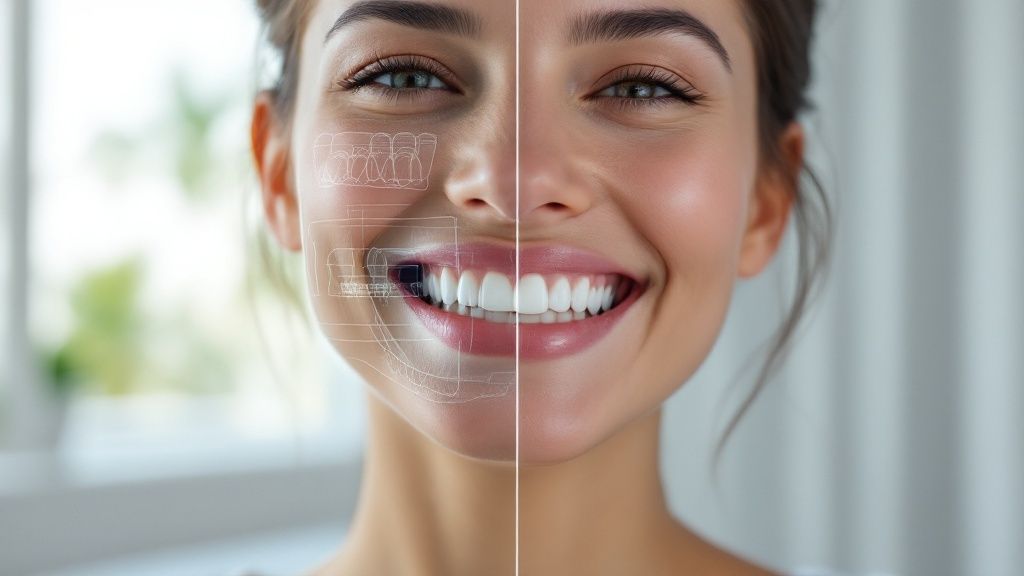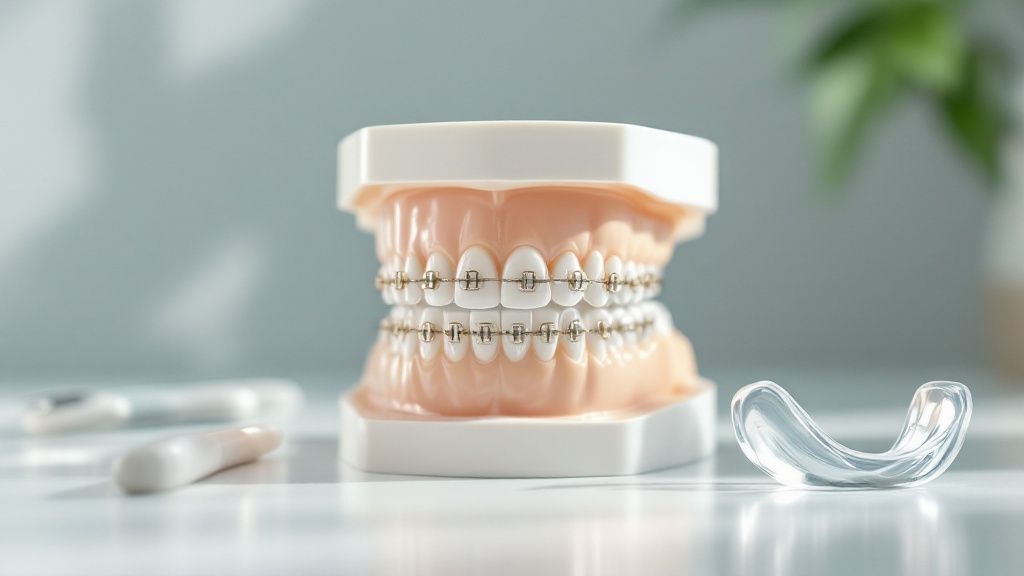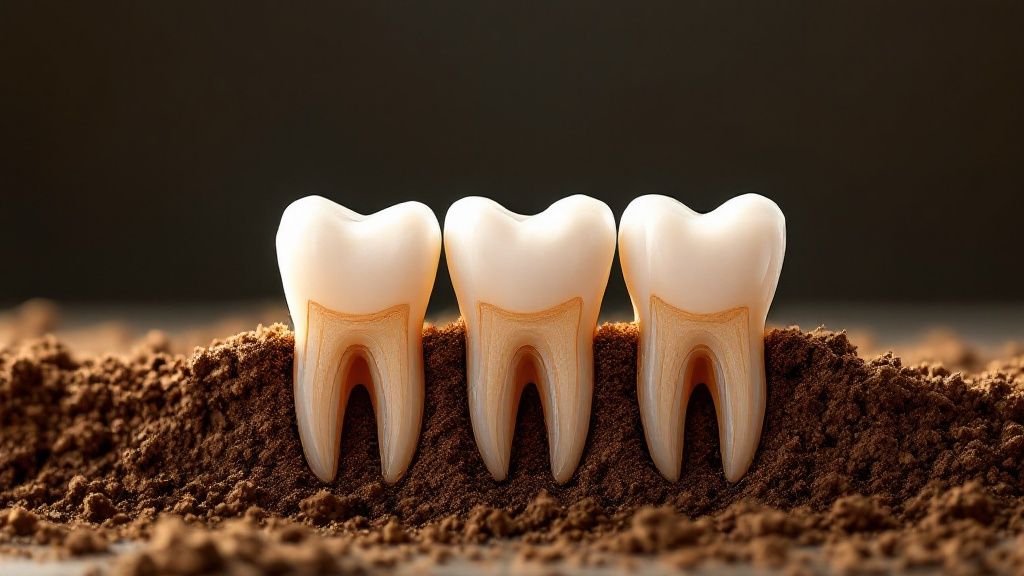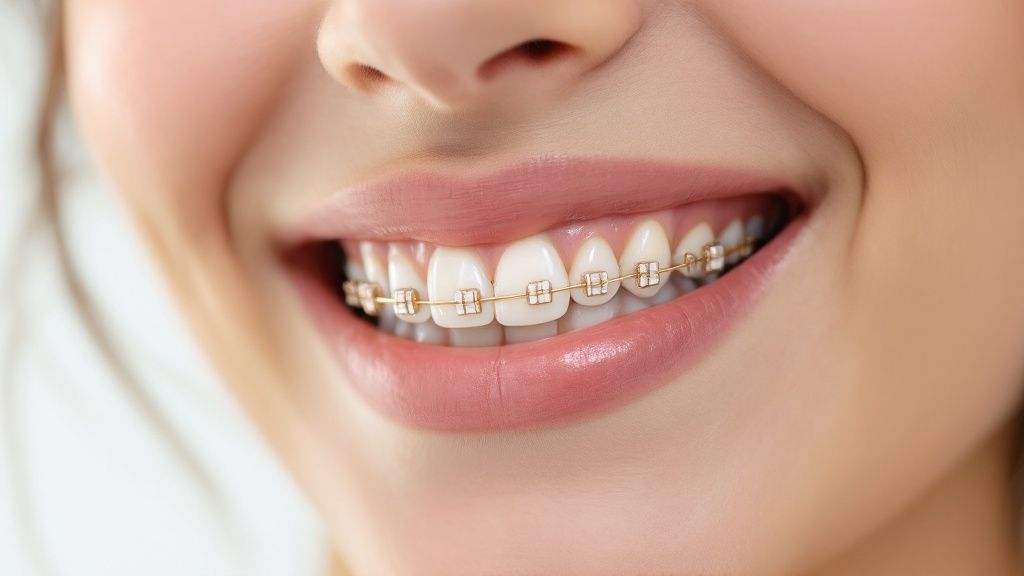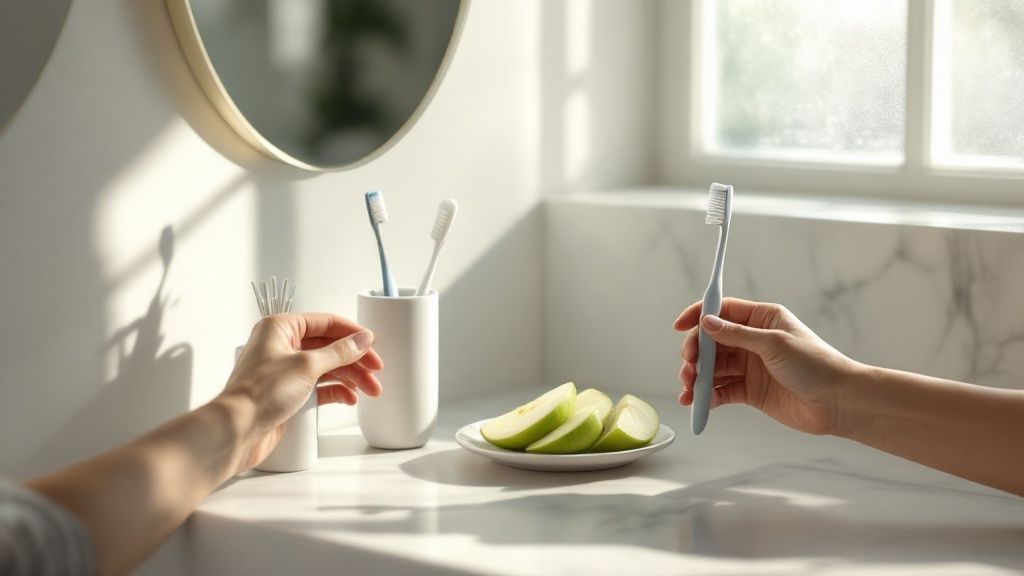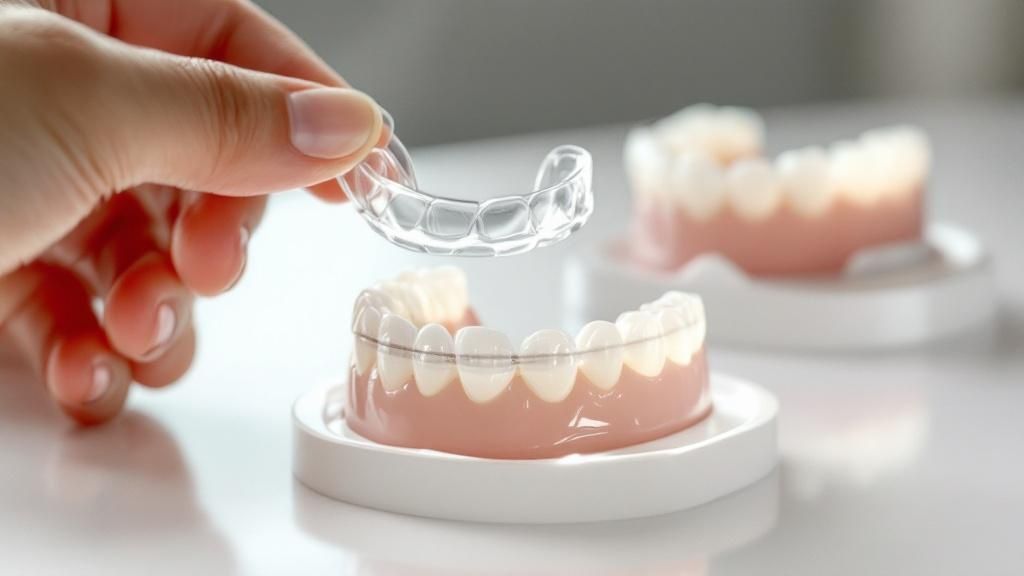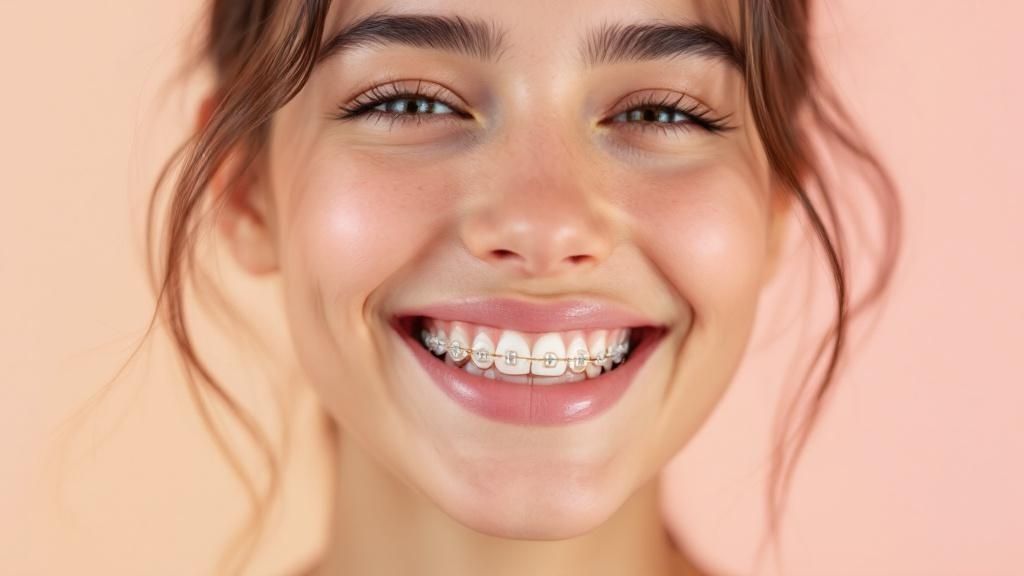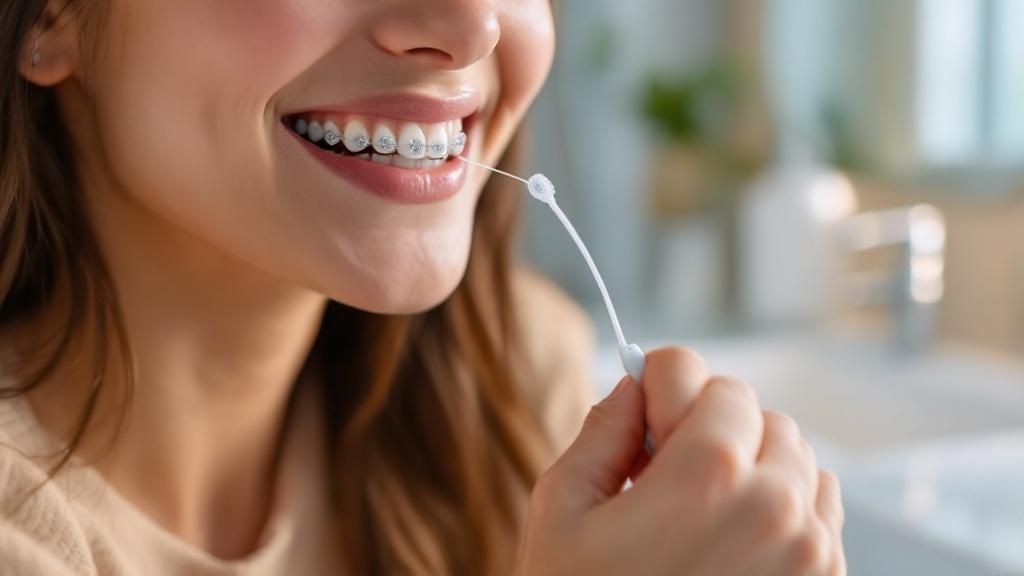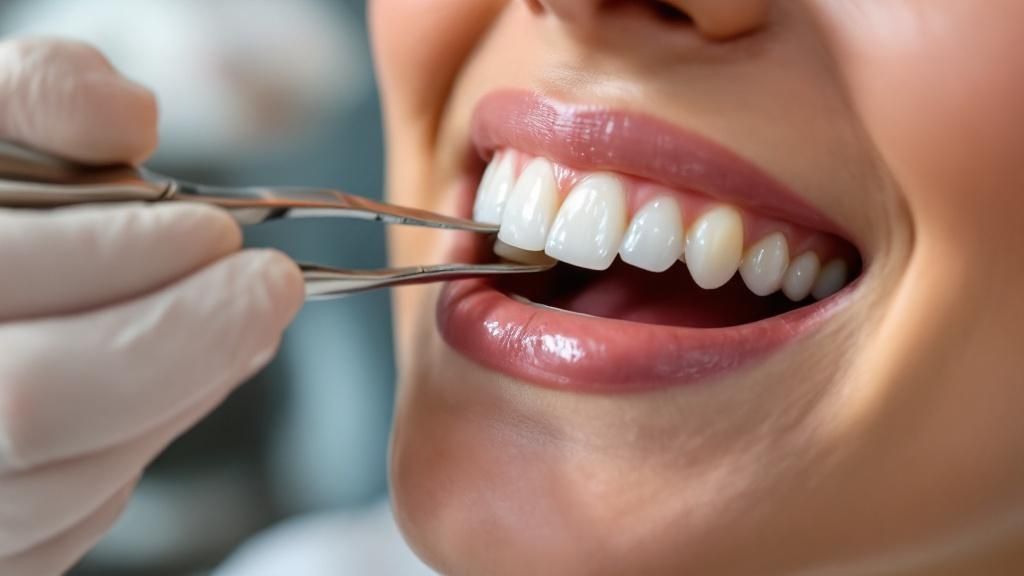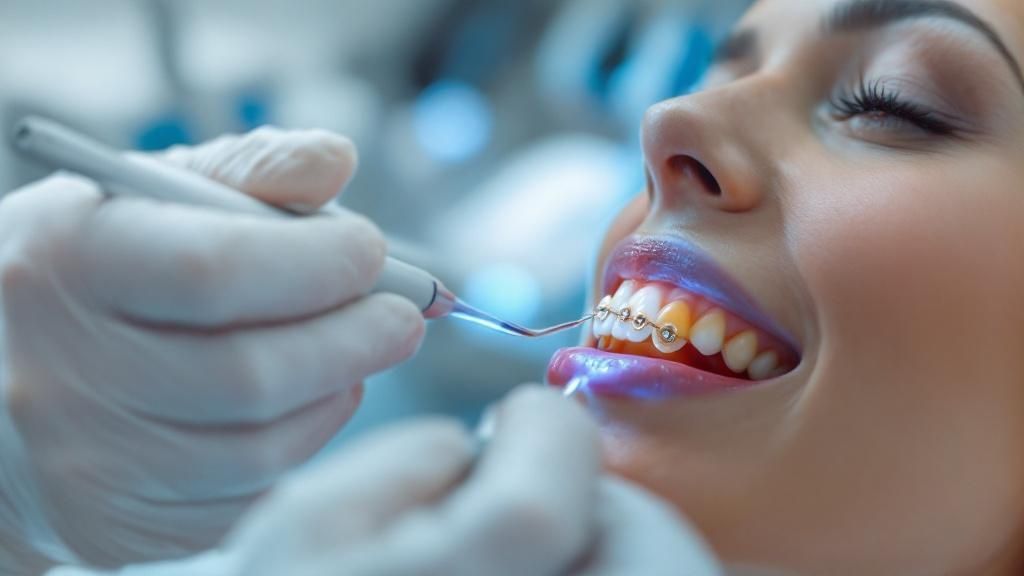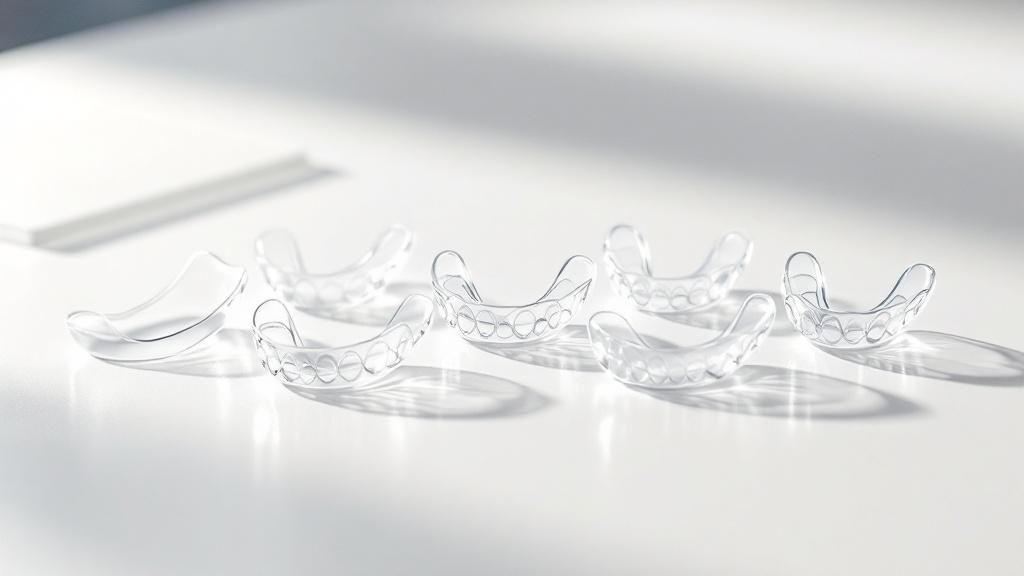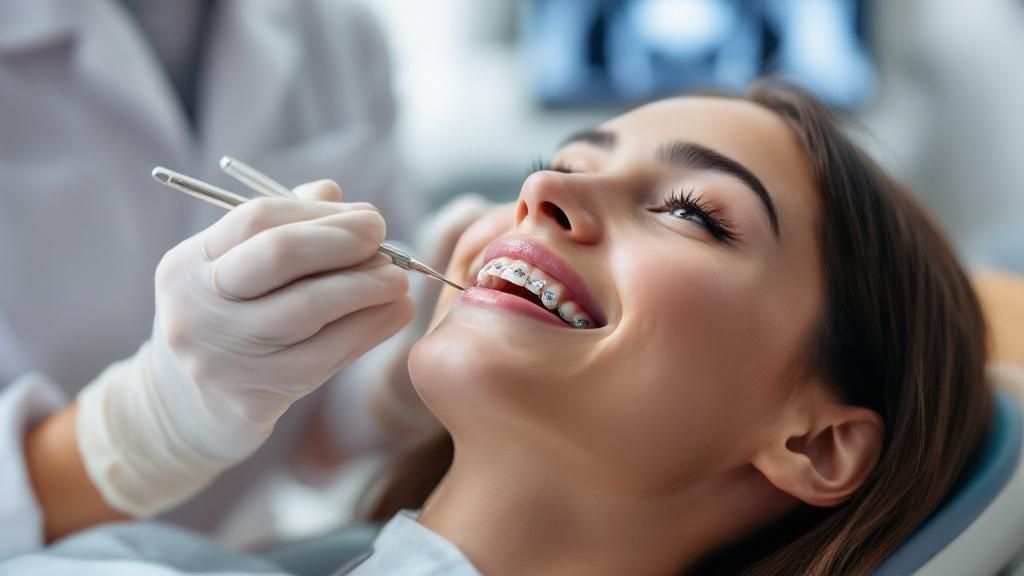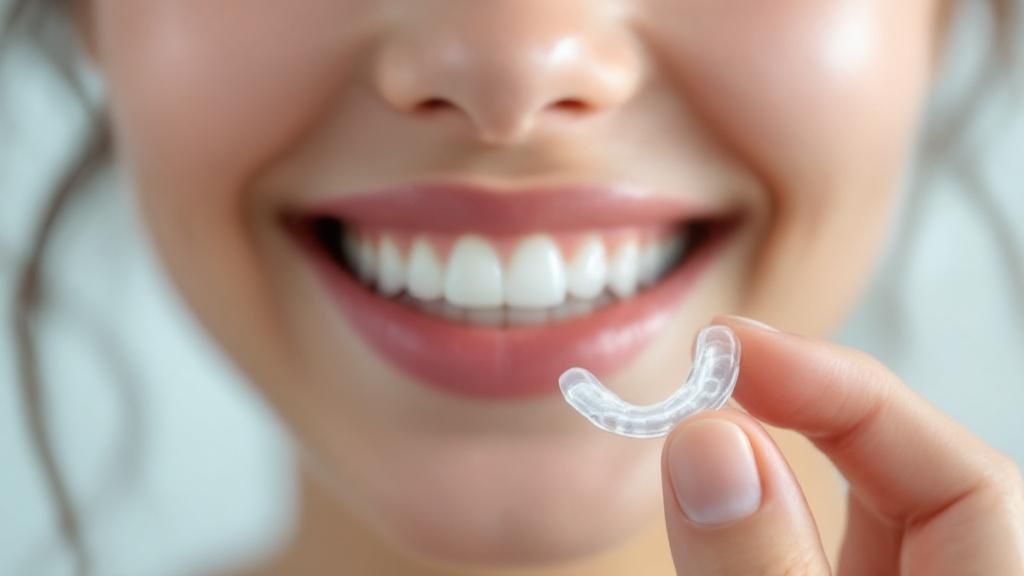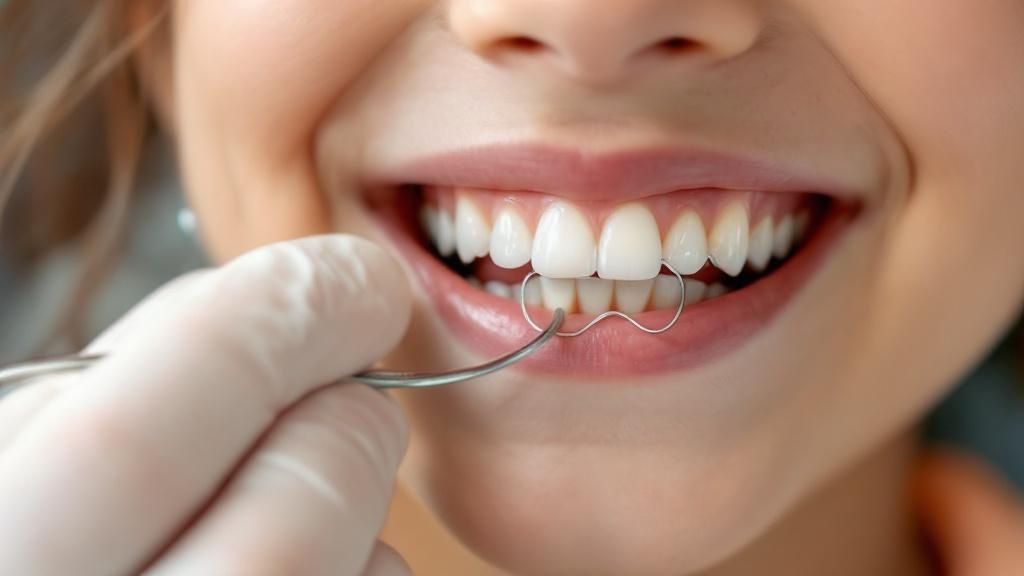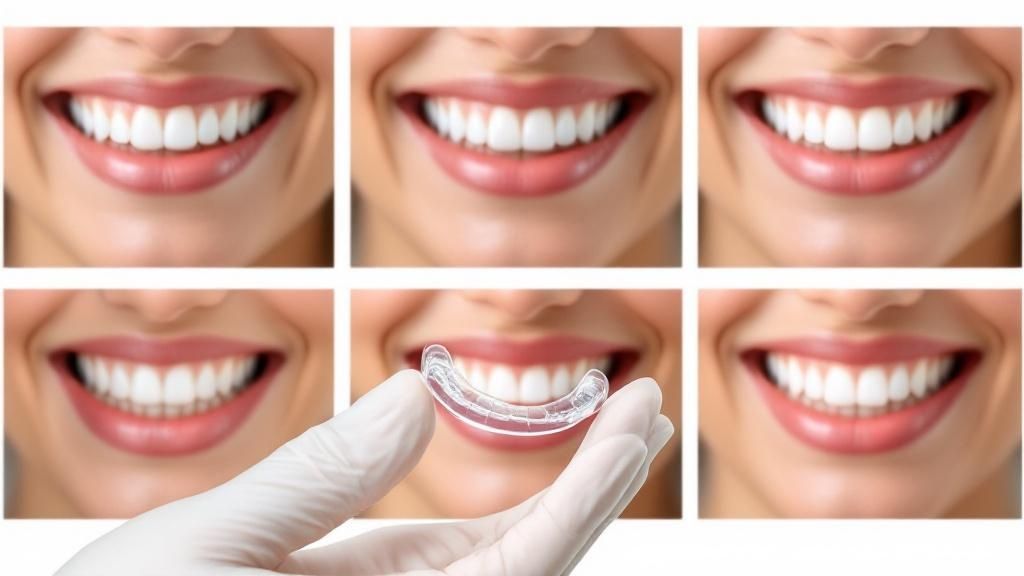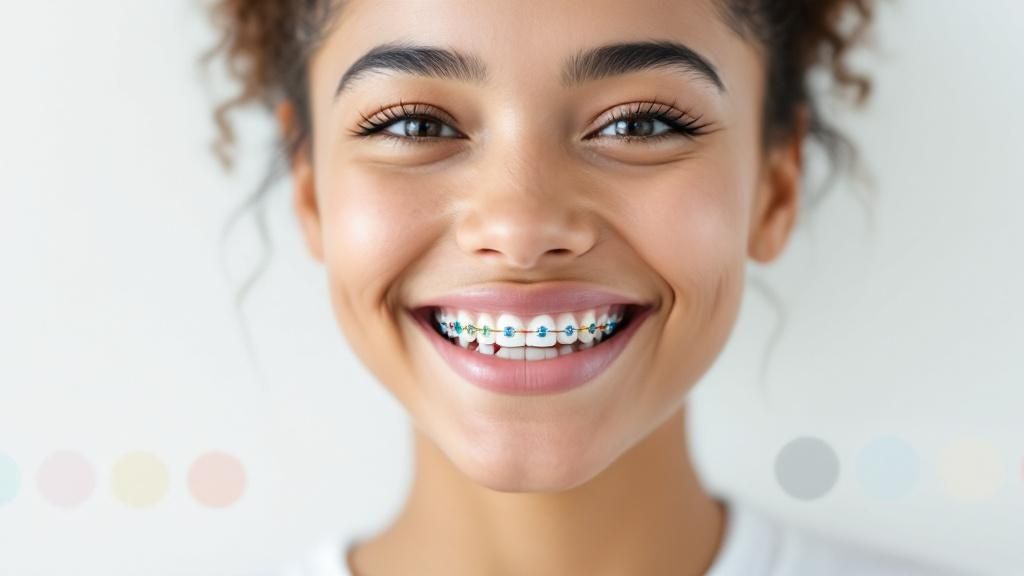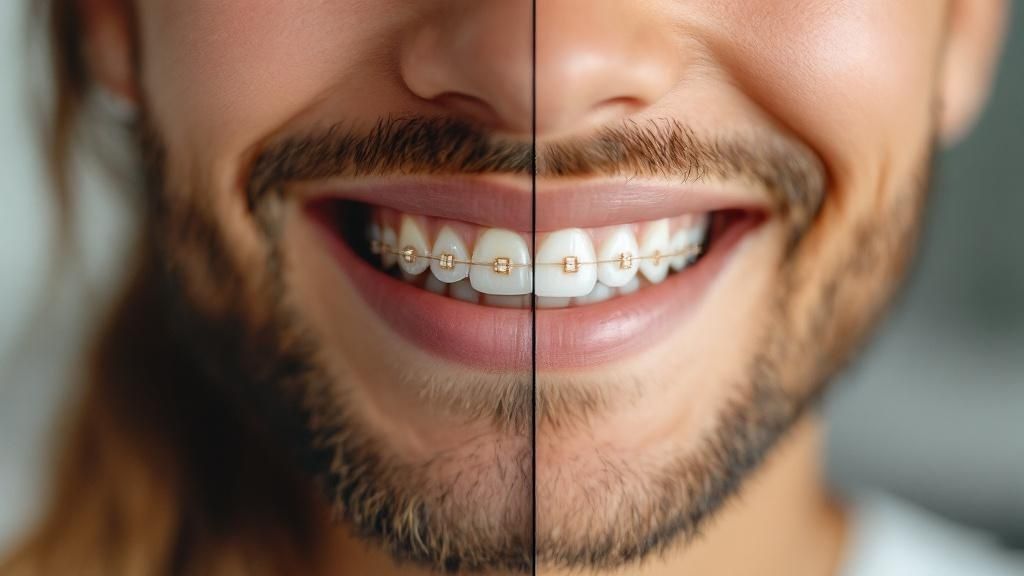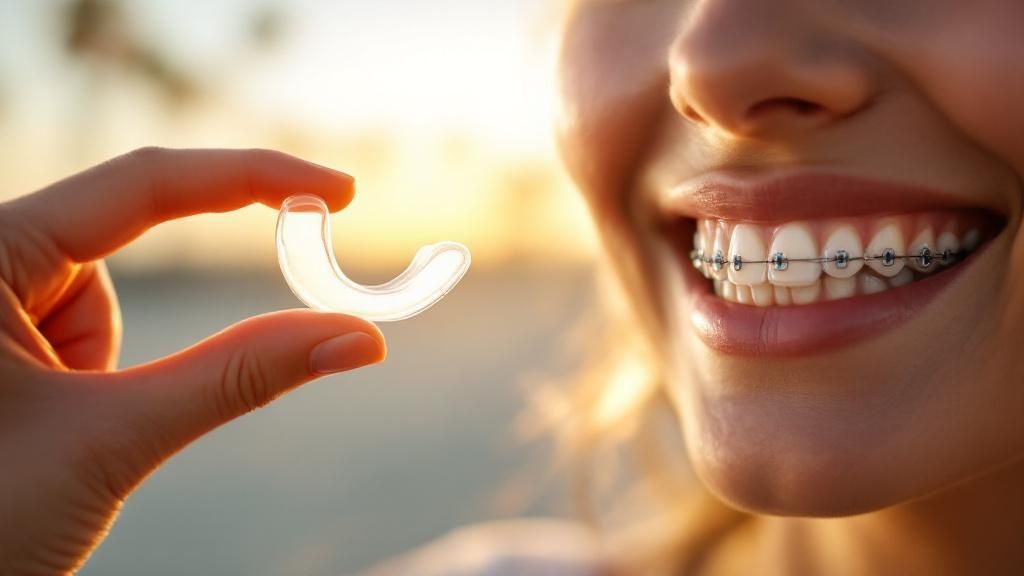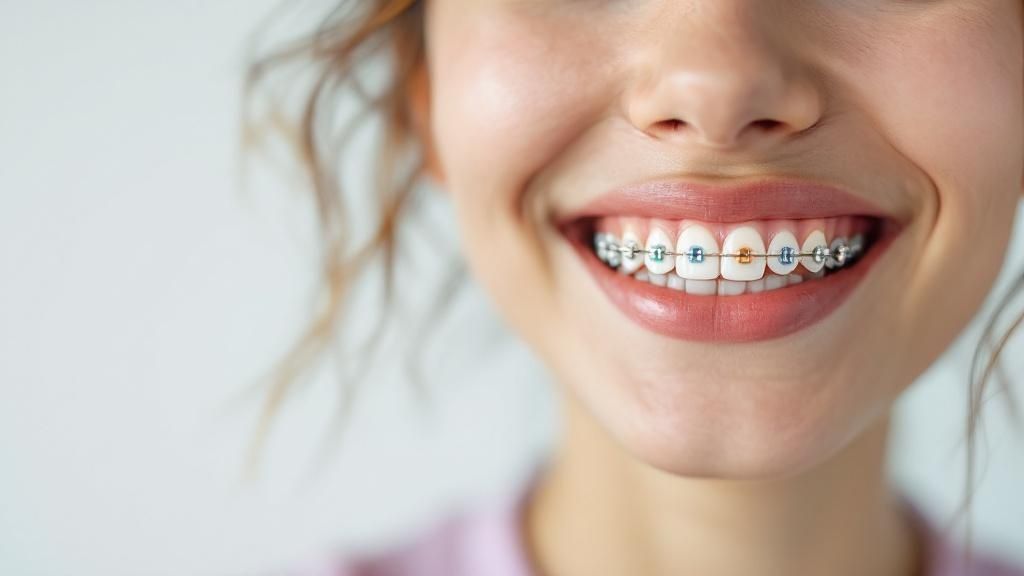
What Causes Tooth Crowding? A Guide for Huntington Beach Families
When your teeth don’t have enough room to grow in straight, they can end up twisted, crooked, or overlapped. This simple mismatch between the size of your teeth and the size of your jaw is the main reason for alignment issues.
Think of it like a game of musical chairs where there aren't enough seats. Some teeth get pushed out of line.
Understanding the Roots of Tooth Crowding
If you've ever looked in the mirror and wondered why your teeth are crowded, you're not alone. It's one of the most common reasons patients walk through our doors here in Huntington Beach.
The great news is that the causes are well-understood. This means we have very effective ways to create a healthy, straight smile you’ll love.
The problem almost always comes down to a simple equation. The total width of your teeth is greater than the space your jaw has to offer.
This condition is a type of malocclusion, which is the technical term for a bad bite. It’s usually driven by a few key factors.
The Main Causes of Crowding
Understanding these factors can help you see why you or your child might be dealing with crowding. For families in Fountain Valley, spotting these signs early can make treatment much simpler.
The main reasons for crowded teeth generally fall into three categories:
- Genetics: This is the big one. You might get your tooth size from one parent and your jaw size from the other. A mix of large teeth and a small jaw is a classic recipe for crowding.
- Early Childhood Development: If a child loses their baby teeth too early, permanent teeth can drift into the empty space. This leaves little room for other adult teeth to come in correctly.
- Oral Habits: Habits like thumb-sucking or tongue thrusting (pushing the tongue against the teeth) can put pressure on the jaws. Over time, this can leave less room for teeth.
This infographic gives a great visual breakdown of the most common reasons for tooth crowding.
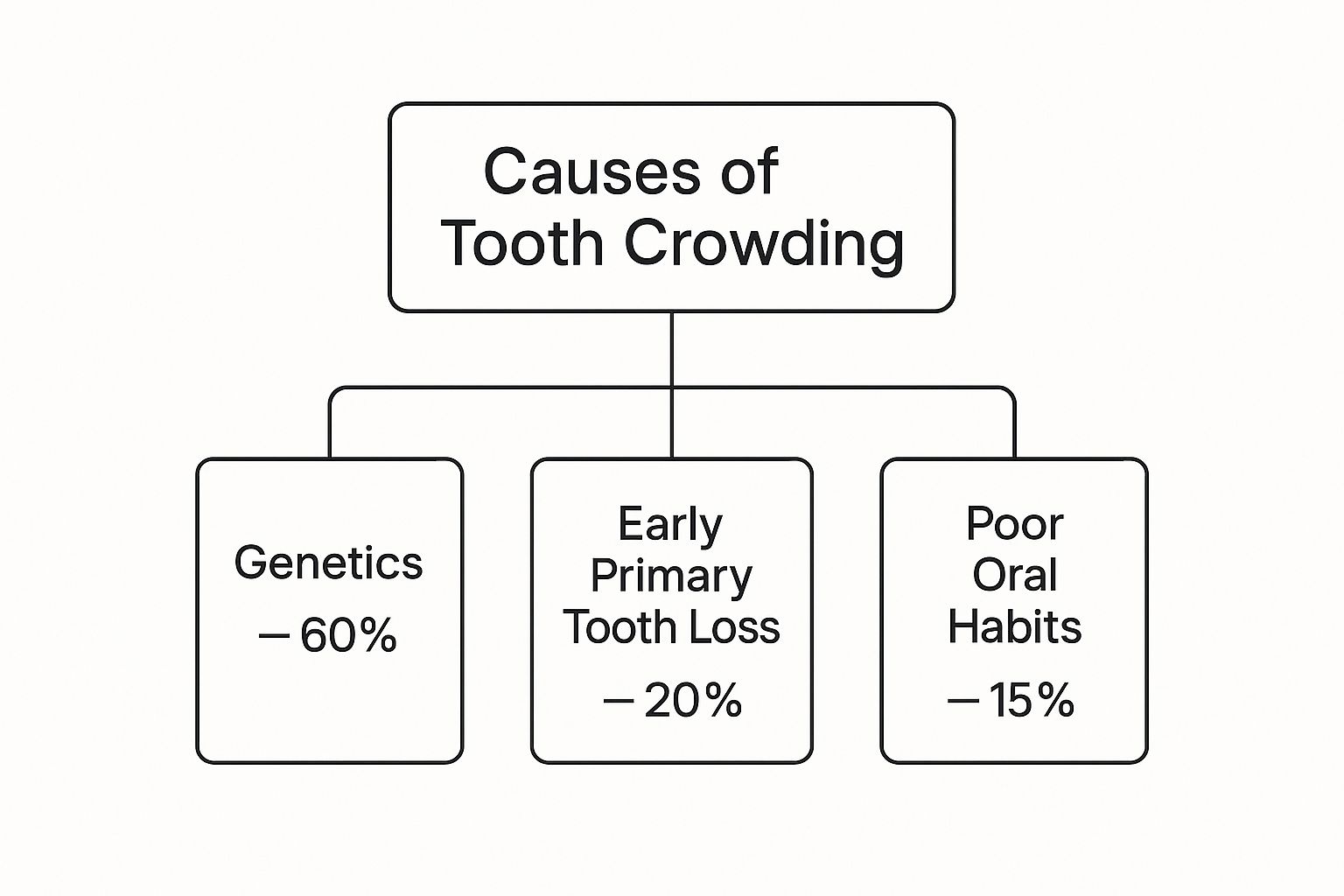
As you can see, genetics plays a huge role. Crowding is a very common issue, affecting somewhere between 30% and 60% of people worldwide.
To give you a quick cheat sheet, we've put together this simple table summarizing the main causes.
Quick Guide to Tooth Crowding Causes
Understanding these factors is the first step toward a solution. Crowding is more than a cosmetic concern. It can also impact your oral health by making it harder to brush and floss.
If you want to dive deeper into this topic, you can check out our detailed guide on what causes crowded teeth.
How Family Genetics Influence Your Smile
Have you ever been told you have your mother’s eyes or your father’s smile? The same genes that determine your hair color also play a leading role in the size of your teeth and jaw.
In fact, genetics is often the single biggest reason why teeth become crowded.
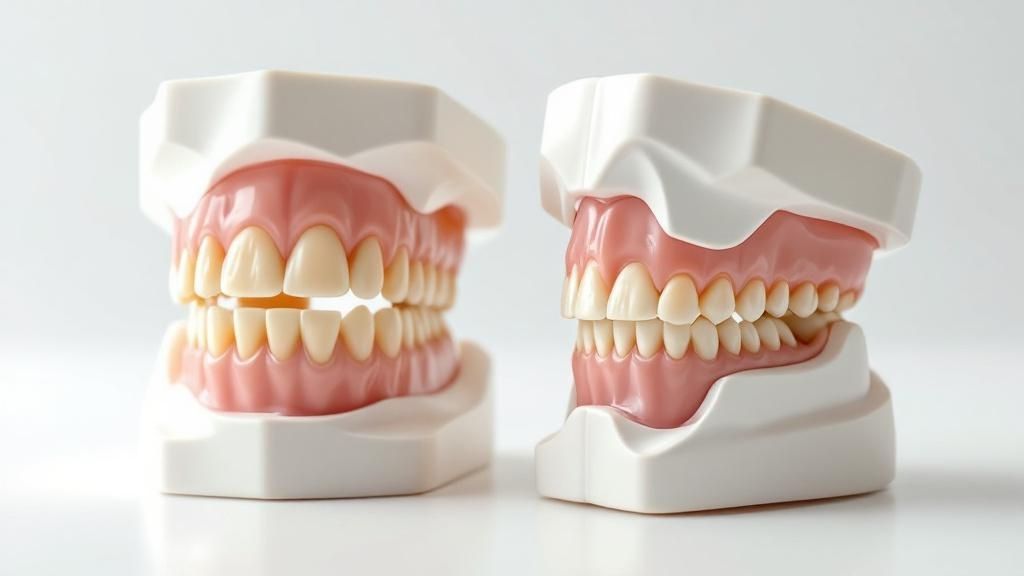
It all comes down to a simple mismatch. You might get your dad's smaller jaw while getting your mom's larger teeth. When those traits combine, there just isn't enough space in your mouth for every tooth.
This is what leads to the overlapping and twisting we call crowding. This genetic puzzle explains why crowding often runs in families.
If you or your partner had crowded teeth, there’s a strong chance your children might have it, too. It’s important for families in our Fountain Valley and Huntington Beach communities to know this isn't your fault—it's just part of your family’s genetic code.
The Genetic Blueprint for Your Bite
Your DNA provides the instructions for countless details about your smile. This makes it easier to see why your teeth look the way they do.
- Tooth Size: The size of each tooth is an inherited trait. Larger teeth naturally require more space.
- Jaw Dimensions: The size of your upper and lower jaws is set by your genes. A smaller jaw is a classic setup for crowding.
- Arch Shape: The U-shape of your dental arch can be wide or narrow, all based on your genes. A narrower arch offers less room.
- Extra or Missing Teeth: Sometimes, genes result in extra teeth (hyperdontia) or missing teeth (hypodontia). Both can throw off the alignment of your smile.
The combination of these inherited factors creates the unique blueprint for your smile. If that blueprint calls for large teeth in a small jaw, crowding is very likely.
This is a common scenario, which is why we see so many patients from neighborhoods like Oak View and Goldenwest with crowding caused by genetics.
Malocclusion, including tooth crowding, can be found in 39% to 93% of children and teens across the globe. This wide range shows how genes and life factors shape our smiles. You can read more about these global orthodontic findings to understand the bigger picture. (Source: National Institutes of Health)
What This Means for Your Family
Knowing that genetics is a major cause of tooth crowding is actually a good thing. It means you can be proactive about your family's oral health without feeling any blame.
While you can't change your genes, you can absolutely correct the alignment issues they cause.
At Magic Fox Orthodontics, we create personalized treatment plans that work with your unique smile. From Invisalign to Iconix brackets, we have solutions to guide teeth into their ideal positions.
If you are concerned about crowding in your lower teeth, you may find our article on using Invisalign for crowded bottom teeth helpful.
The Impact of Childhood Development on Teeth
While genes provide the blueprint for your smile, a child's early years are also very important for developing straight teeth. Your child’s baby teeth are like little placeholders, saving a spot for each permanent tooth.
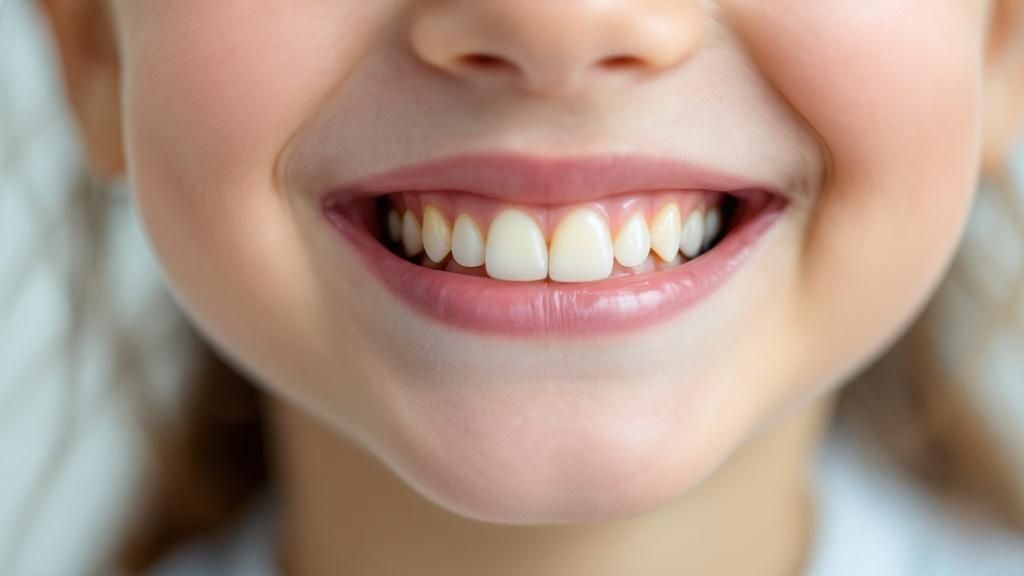
This natural process works great when everything stays on schedule. But if a baby tooth is lost too soon, it can set off a chain reaction of alignment issues.
The other teeth tend to drift into that empty space. When the adult tooth is finally ready to come in, its path is blocked. This forces the tooth to come in crooked, leading to crowding.
When Baby Teeth Fall Out Too Soon
This happens more often than many parents think. Imagine a child in the Goldenwest neighborhood loses a baby molar a year or two early.
Without that placeholder, the big permanent molar behind it can shift forward. This leaves no room for the tooth that was supposed to take its place.
This is why early orthodontic check-ups are so important. Dental crowding is most common in the 6-15 years age group—the exact time when permanent teeth are coming in.
One study found that about 74% of patients had some form of dental crowding. This shows how common this issue is during these years. You can learn more about these dental crowding findings to see the full picture.
The main job of a baby tooth is to hold space for the permanent tooth that will replace it. Losing one too early can affect the entire structure of the smile.
Protecting Your Child's Developing Smile
Keeping baby teeth healthy is one of the best ways to prevent future crowding. Here’s what parents in Huntington Beach can do to protect their child’s smile:
- Prioritize Dental Hygiene: Brushing and flossing baby teeth is key to preventing decay and early tooth loss.
- Schedule Regular Dental Visits: Routine check-ups allow your dentist to monitor your child's growth and spot problems early.
- Consider a Space Maintainer: If a baby tooth is lost early, an orthodontist can place a simple device to hold the gap open until the permanent tooth is ready.
By understanding these key developmental factors, you can take steps to guide your child’s smile in the right direction. For more information, you might be interested in our guide on understanding the importance of early orthodontic care for kids.
Oral Habits That Contribute to Crowding
It’s not just about genetics or how the jaw grows. Sometimes, the little habits kids have can play a surprisingly big role in how their smile develops.
These actions might seem harmless. But the gentle, constant pressure they create can nudge teeth and jaws out of alignment, often leading to crowding.
For parents here in Huntington Beach, understanding these habits is one of the best ways to give your child a head start on a healthy, straight smile.

Many of these habits are normal ways for young children to comfort themselves. The trouble starts when they continue for too long.
That constant pressure can narrow the upper jaw, meaning there’s less room for permanent teeth. This is a common factor we look for during early screenings for families in the Fountain Valley area.
Common Habits That Affect Alignment
Spotting these habits early is the first step toward preventing bigger orthodontic issues later. It’s about knowing when a habit might be impacting long-term oral health.
Here are some of the most common habits we see:
- Prolonged Thumb-Sucking: When a thumb rests against the roof of the mouth, it can physically narrow the upper jaw. It also pushes the front teeth forward, stealing space from other teeth.
- Extended Pacifier Use: A pacifier can have a similar effect as a thumb. If used too long, it can change the shape of the jaw and contribute to crowding.
- Tongue Thrusting: This is a habit where the tongue pushes against the front teeth when swallowing or talking. That forward pressure can disrupt the alignment of the entire arch.
It's pretty simple: teeth and bone will move in response to constant, gentle pressure. When a habit applies that pressure day after day, it can lead to crowded and crooked teeth.
When to Seek an Evaluation
The good news is that the effects of these habits are often fixable, especially when caught early. If you notice your child has a persistent oral habit past the age of four or five, it’s a great time to schedule an orthodontic check-up.
We can see how their jaw is developing and if any simple steps are needed. To learn more, check out our post about braces and oral habits for more insights.
Addressing these issues early can often lead to simpler treatment for your child later on.
Modern Orthodontic Solutions for Crowded Teeth
Understanding what causes your teeth to crowd is the first step. The best part is knowing there are fantastic, modern ways to fix it.
Here at Magic Fox Orthodontics, we love creating healthy, straight smiles for families all over Huntington Beach. Our goal is to find the perfect treatment that fits your lifestyle and gives you a smile you’ll love to share.
Once we know the root cause of the crowding, we can map out a personalized game plan. We have several effective treatment options that all share the same mission: gently guiding your teeth into their ideal positions.
Tailored Treatments for Your Smile
For our patients in Wintersburg and the surrounding neighborhoods, we offer a few great choices. We’ll sit down with you, explain the benefits of each, and help you decide which one is the best fit.
- Invisalign Clear Aligners: A popular choice for teens and adults who want to straighten their teeth discreetly. The aligners are clear, removable trays that are nearly invisible. You can take them out to eat and clean your teeth normally.
- Iconix Esthetic Brackets: If you want the power of braces with a more subtle look, Iconix is a perfect match. Their unique champagne-colored stainless steel blends in beautifully with your natural tooth color.
- Traditional Metal Braces: Sometimes, you can't beat the original. Metal braces are the gold standard because they provide the reliable force needed to correct even the most severe cases of crowding.
No matter why your teeth are crowded, there's a modern orthodontic solution ready to help. The key is a personalized treatment plan designed by an orthodontic specialist.
Comparing Your Options
Choosing the right path is a big decision, and we’re here to make it simple. For many adults right here in Fountain Valley, the discreet nature of aligners is a huge plus.
You can find out more by checking out our guide to adult orthodontics in Fountain Valley.
If you're curious about the science behind what we do, you can explore resources on the field of orthodontics. To help you compare the options we offer, we've put together a simple table.
Comparing Crowding Treatments at Magic Fox Orthodontics
Here’s a quick breakdown of the solutions we offer at our Huntington Beach office to help you see which one might be the best fit.
The best choice depends on your specific needs and personal preferences. We’re here to walk you through every detail during your consultation to find the perfect fit.
Frequently Asked Questions
As orthodontists in Huntington Beach, we get a lot of great questions from families about crowded teeth. Getting clear, straightforward answers is the best way to feel confident about your journey.
At What Age Should My Child Be Checked for Crowding?
The American Association of Orthodontists recommends every child have their first orthodontic check-up around age 7. This is the perfect time for an expert to spot subtle issues with jaw growth and how permanent teeth are coming in.
An early evaluation doesn't mean your child will get braces right away. It just gives us a chance to monitor their development and plan for the best time to start treatment if it's needed.
Can Tooth Crowding Get Worse Over Time?
Yes, in most cases, tooth crowding will get worse if left untreated. As we age, our teeth naturally tend to shift forward, a process called mesial drift.
This slow movement can make existing crowding worse. This is why many adults notice their lower front teeth becoming more overlapped over time. This is also why wearing your retainer after treatment is so important.
Does Tooth Crowding Cause Other Dental Problems?
Absolutely. Crowded teeth are much more than a cosmetic issue. Overlapped and twisted teeth are harder to clean with daily brushing and flossing.
This increases the risk of cavities and gum disease. Crowding can also lead to uneven tooth wear and jaw pain from a misaligned bite.
Crowded teeth create tight spaces where plaque can hide. This directly increases the risk for cavities and gum inflammation (gingivitis).
Will Wisdom Teeth Make My Other Teeth Crowd?
This is a common myth. For a long time, people believed that wisdom teeth were a primary cause of crowding in the front teeth.
However, modern research shows that wisdom teeth don't usually exert enough pressure to cause that kind of movement. The crowding many people experience later in life is more often due to natural aging and shifting.
Is It Possible to Fix Crowded Teeth Without Extractions?
Yes, it’s often possible to fix crowded teeth without pulling any permanent teeth. Modern orthodontic techniques have given us great non-extraction alternatives.
Here at Magic Fox Orthodontics, we believe in preserving healthy teeth whenever we can. We often create space using methods like arch expansion, which gently widens the dental arch to make more room. We will always explore every non-extraction option first.
Ready to transform your smile? The team at Magic Fox Orthodontics is here to help you understand the causes of tooth crowding and find the perfect solution. Contact us today in Huntington Beach to schedule your free consultation

